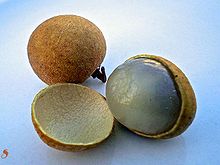- Longan
-
For other uses, see Long'an (disambiguation).
Longan
Dimocarpus longan

Longan fruit Conservation status Scientific classification Kingdom: Plantae (unranked): Angiosperms (unranked): Eudicots (unranked): Rosids Order: Sapindales Family: Sapindaceae Genus: Dimocarpus Species: D. longan Binomial name Dimocarpus longan
Lour.Synonyms Euphoria longan Steud.
Euphoria longana Lamk (1792)
Nephelium longana CambessDimocarpus longan, commonly known as the longan, is a tropical tree native to South and Southeast Asia,[1] in the Indomalaya ecozone[2] known for its edible fruit.
Contents
Vernacular names
The fruit is known as longan or longyan in English. It is also known as, in simplified Chinese: 龙眼; traditional Chinese: 龍眼; Mandarin Pinyin: lóngyǎn; Jyutping: lung4 ngaan5; literally "dragon eye", in Lao: ລໍາໄຍ Lam Yai, in Vietnamese: Long Nhãn/Nhãn, in Malaysian: mata kucing, literally "cat's eye", in Indonesian: Kelengkeng, in Sinhala: Mora or Lengkeng, in Thai: ลำไย Lam Yai, in Filipino: Longan, in Bangladesh : Ashfal, Tamil: முதலிப் பழம் (Muthali Pazham)
Description
The Dimocarpus longan tree can grow up to 6 to 7 metres in height, and the plant is very sensitive to frost. Longan trees require sandy soil and temperatures that do not typically go below 4.5 degrees Celsius (40.1 degrees Fahrenheit). Longans and lychees bear fruit at around the same time of the year.
The longan (translated literally as "dragon eye") is so named (from its transliteration from Amoy) [liong-gan] because its fruit, when it is shelled, resembles an eyeball (the black seed shows through the translucent flesh like a pupil/iris). The seed is small, round and hard, and of an enamel-like, lacquered black. The fully ripened, freshly harvested shell is bark-like, thin, and firm, making the fruit easy to shell by squeezing the fruit out as if one is "cracking" a sunflower seed. When the shell has more moisture content and is more tender, the fruit becomes less convenient to shell. The tenderness of the shell varies due to either premature harvest, variety, weather conditions, or transport/storage conditions.
The longan is listed as Near Threatened on the IUCN Red List.[3]
Culinary uses
The fruit is edible, extremely sweet, juicy and succulent in superior agricultural varieties, and apart from being eaten fresh, is also often used in East Asian soups, snacks, desserts, and sweet-and-sour foods, either fresh or dried, sometimes canned with syrup in supermarkets.
Dried longan, called guìyuán (桂圆) in Chinese, are often used in Chinese cuisine and Chinese sweet dessert soups. In Chinese food therapy and herbal medicine, it is believed to have an effect on relaxation. In contrast with the fresh fruit, which is juicy and white, the flesh of dried longans is dark brown to almost black. In Chinese medicine the longan, much like the lychee, is thought to give internal "heat" (上火).
Cultivation
Potassium chlorate has been found to cause the longan tree to blossom. However, this causes stress on the tree if it is used excessively, and eventually kills it.[4]
See also
References
- ^ "Longan: Dragon Eye Fruit". Exotic Fruit For Health. 28 August 2011. http://www.exoticfruitx.com/2011/08/longan-dragon-eye-fruit/. Retrieved 3 November 2011.
- ^ http://www.angelfire.com/planet/wildlifesl/articles/dn_bears_buffaloes.htm
- ^ World Conservation Monitoring Centre (1998). Dimocarpus longan. 2006. IUCN Red List of Threatened Species. IUCN 2006. www.iucnredlist.org. Retrieved on 9 May 2006.
- ^ Manochai, P.; Sruamsiri, P.; Wiriya-alongkorn, W.; Naphrom, D.; Hegele, M.; Bangerth, F. (February 12, 2005). "Year around off season flower induction in longan (Dimocarpus longan, Lour.) trees by KClO3 applications: potentials and problems". Scientia Horticulturae (Department of Horticulture, Maejo University, Chiang Mai, Thailand; Department of Horticulture, Chiang Mai University, Chiang Mai, Thailand; Institute of Special Crops and Crop Physiology, University of Hohenheim, 70593 Stuttgart, Germany) 104 (4): 379–390. http://www.actahort.org/books/863/863_48.htm. Retrieved November 28, 2010.
External links
Categories:- IUCN Red List near threatened species
- Dimocarpus
- Tropical fruit
- Fruits originating in Asia
- Indomalaya flora
- Flora of Indochina
- Flora of Indomalesia
- Flora of China
- Flora of Vietnam
- Flora of Laos
- Flora of Cambodia
- Trees of Thailand
- Flora of Malaysia
- Flora of Burma
- Flora of Bangladesh
- Flora of India
- Cambodian cuisine
- Chinese ingredients
- Malaysian cuisine
- Lao ingredients
- Thai ingredients
- Vietnamese ingredients
- Near threatened plants
- Nephelium
- Sapindaceae
Wikimedia Foundation. 2010.


